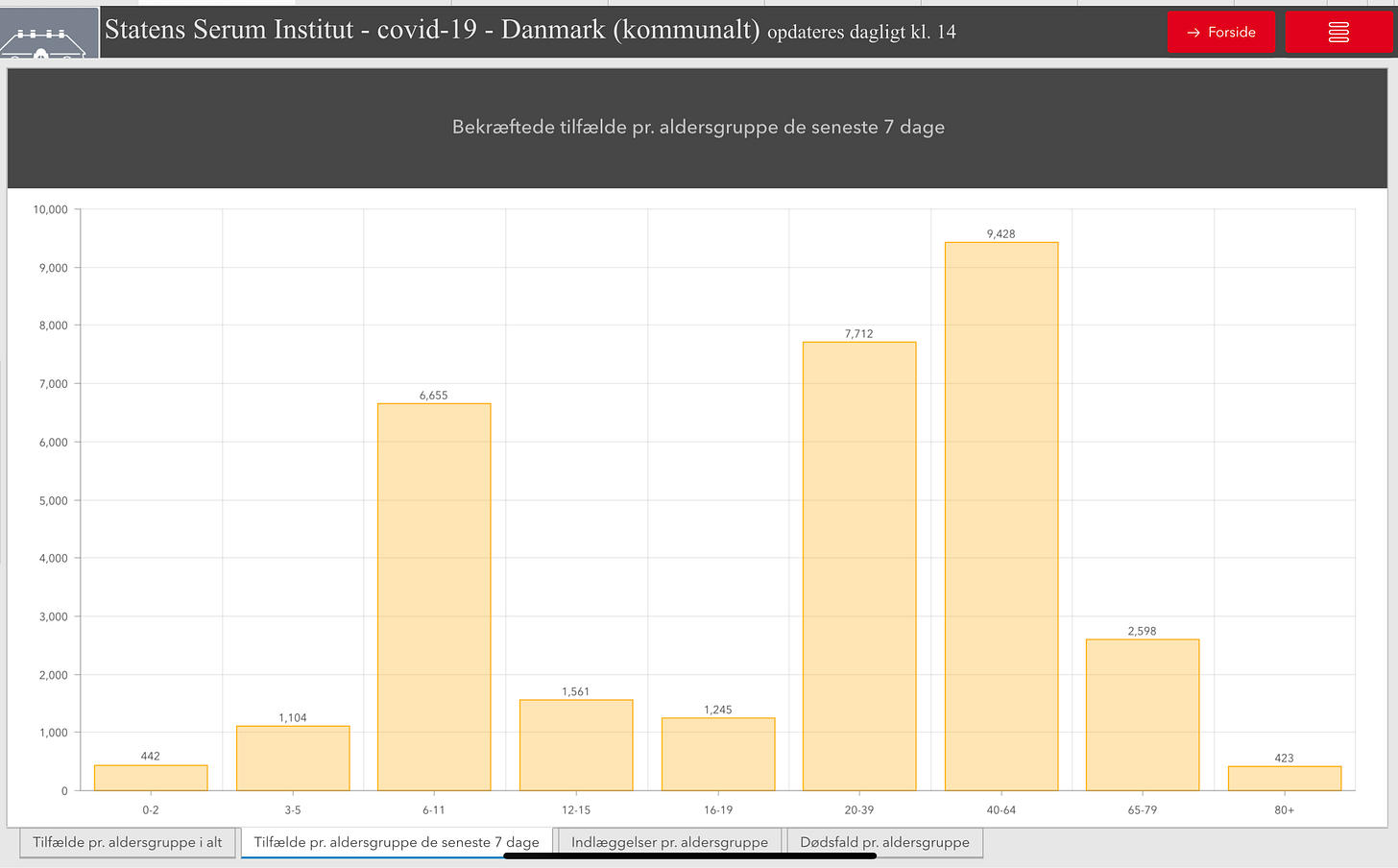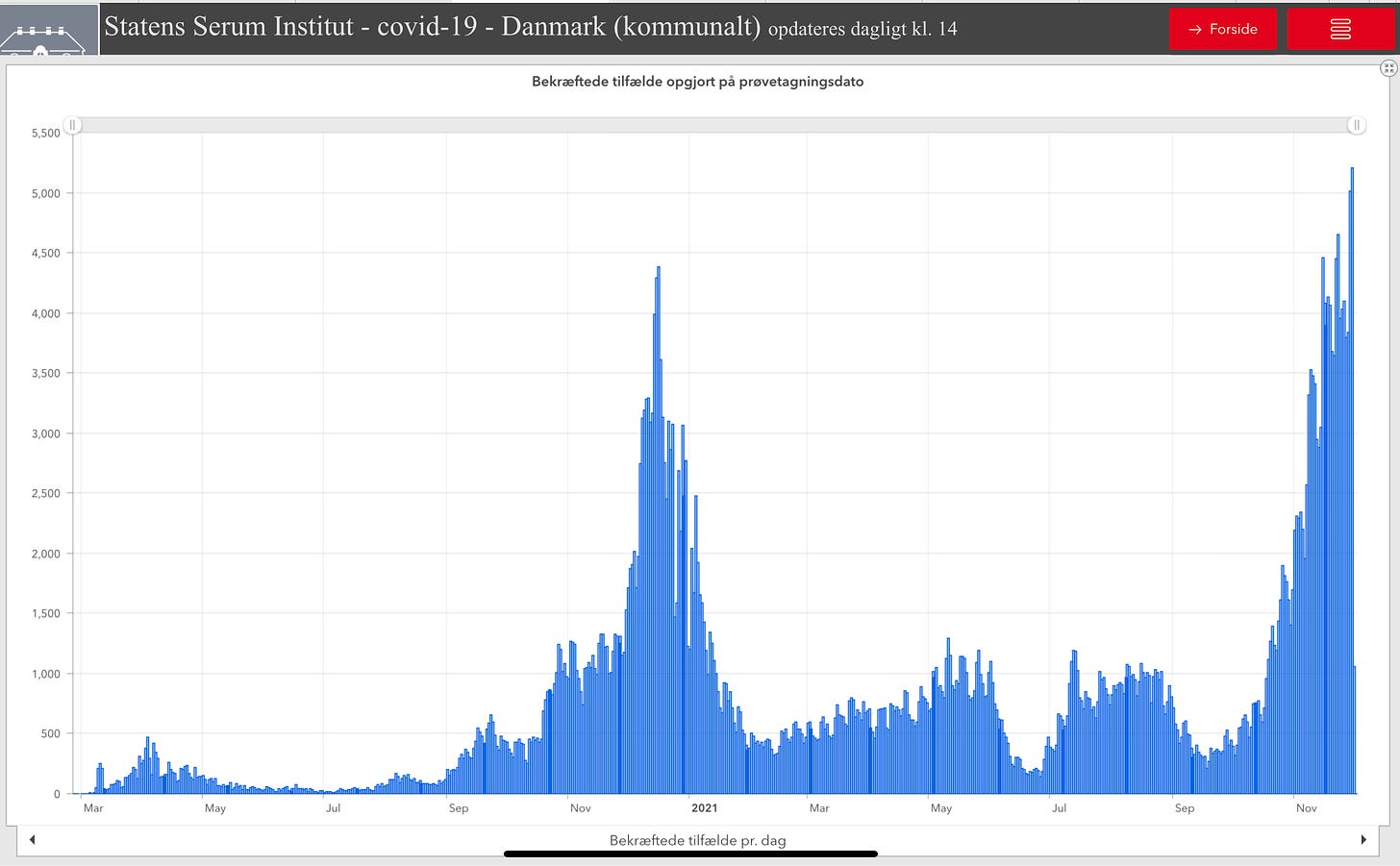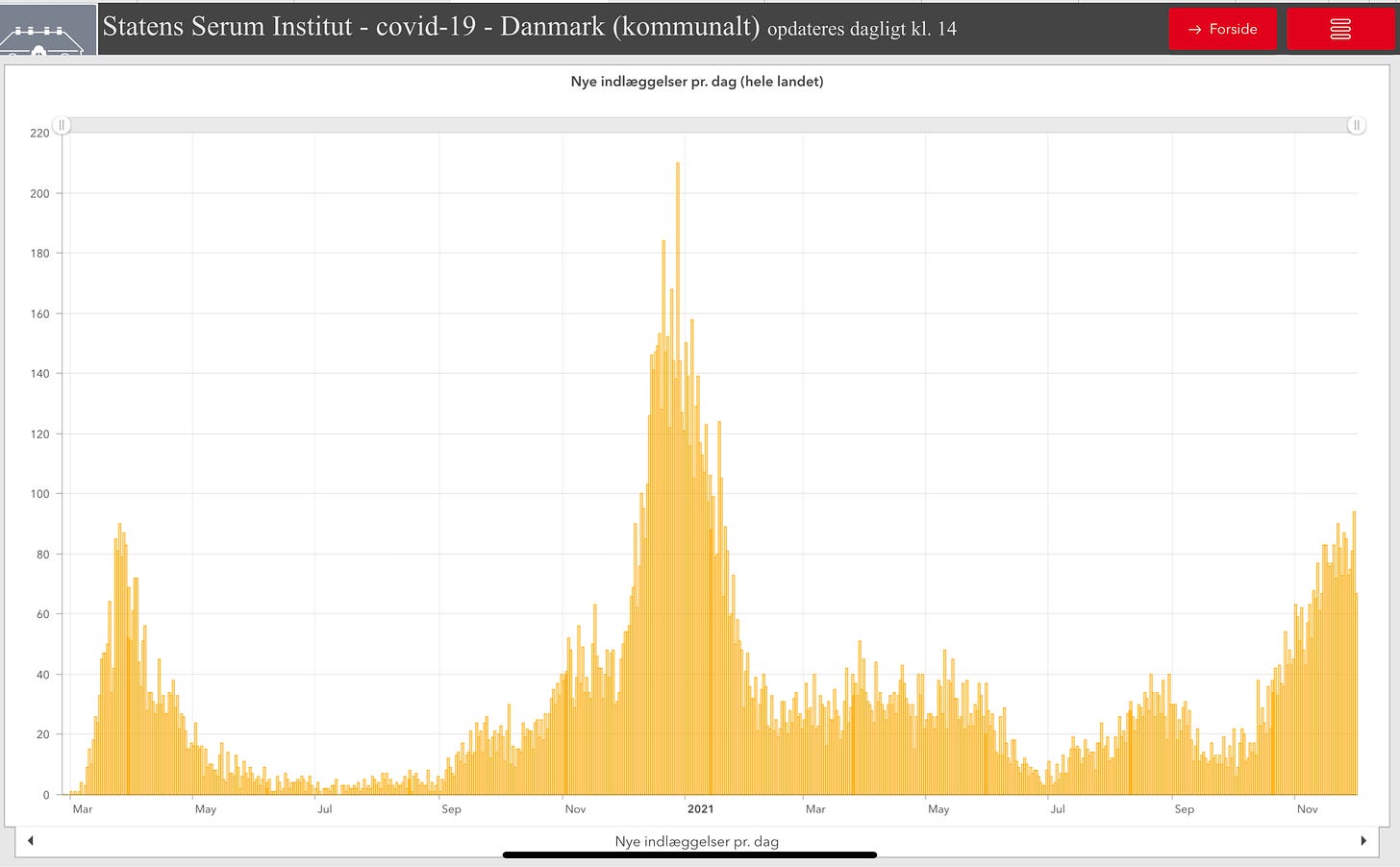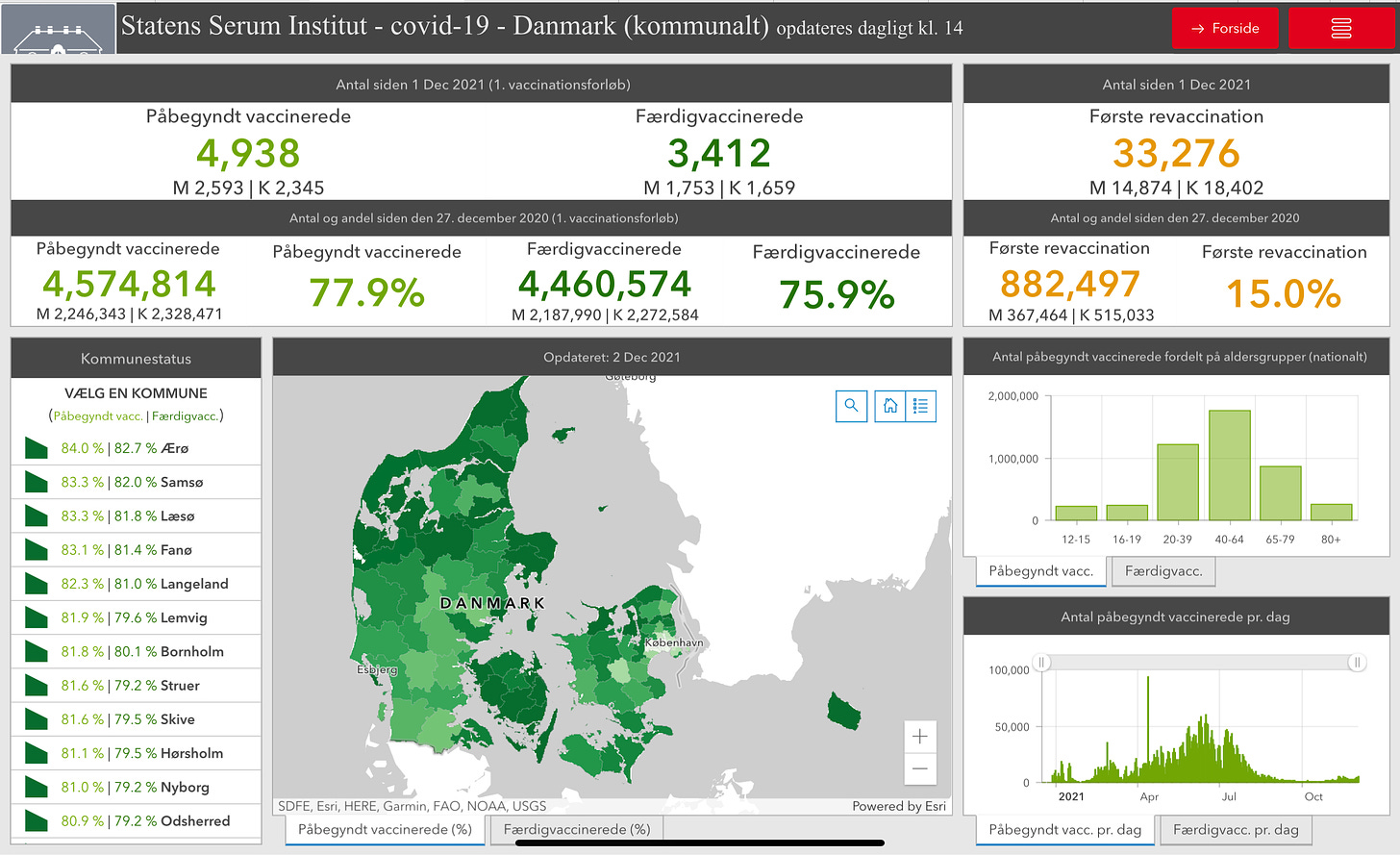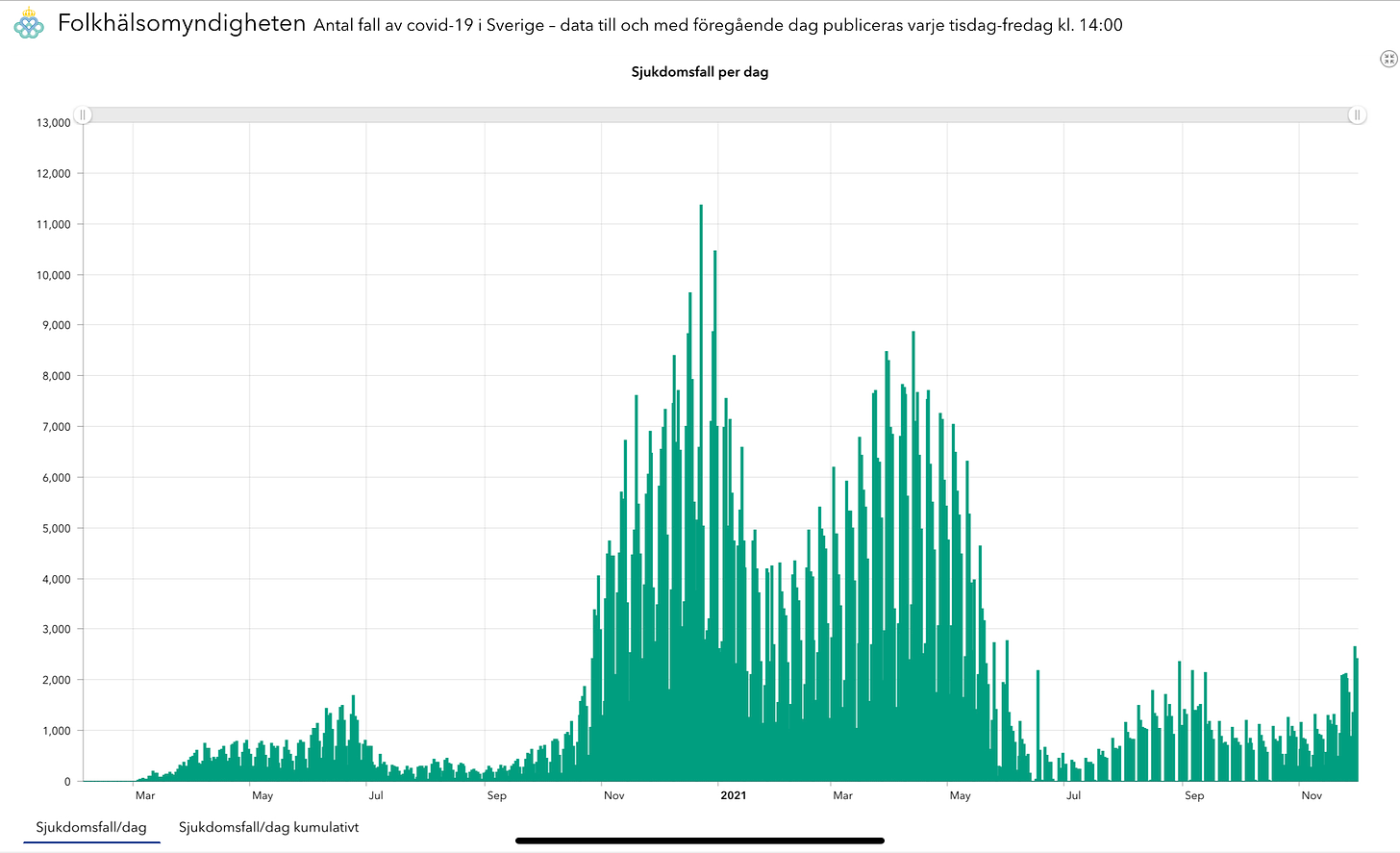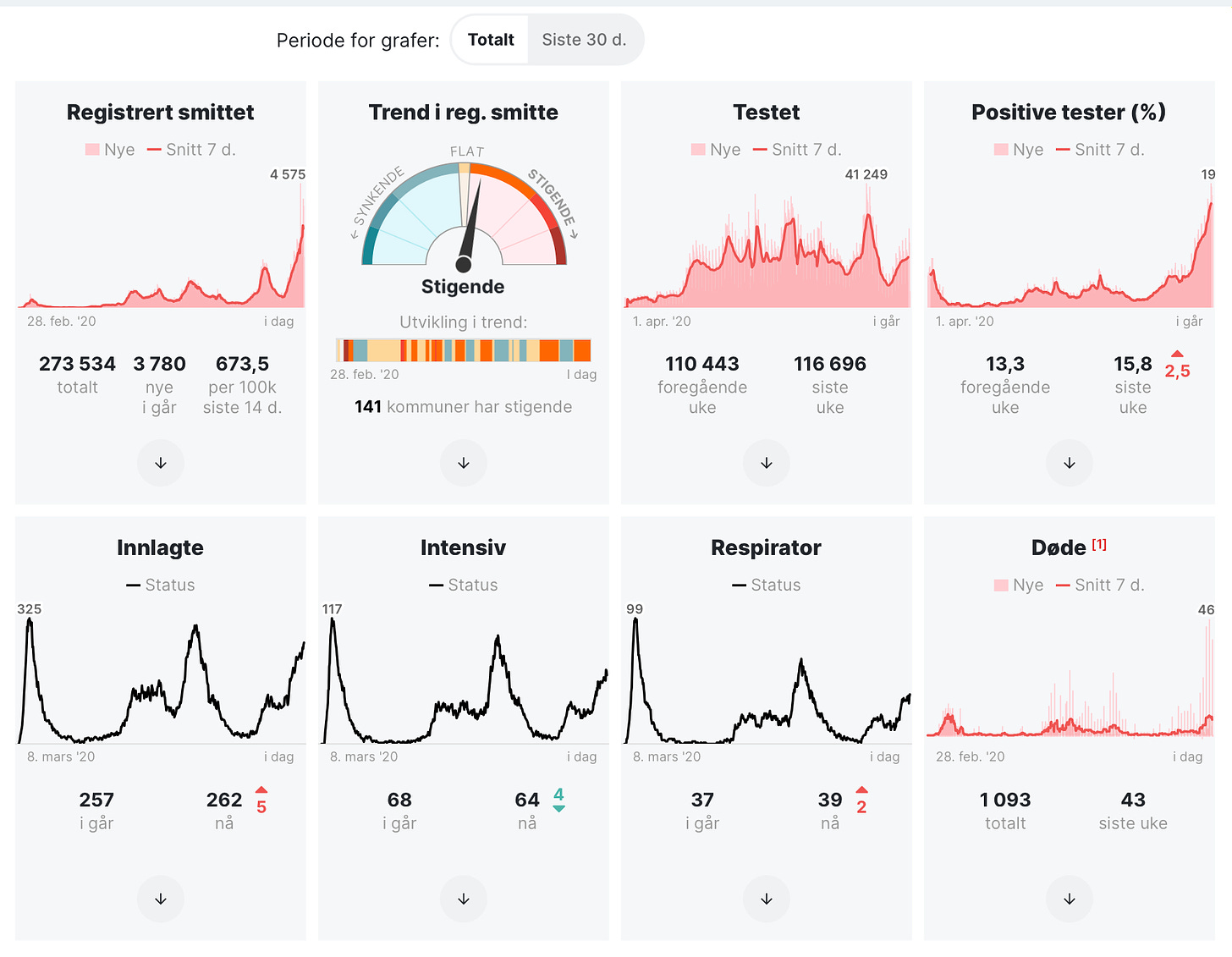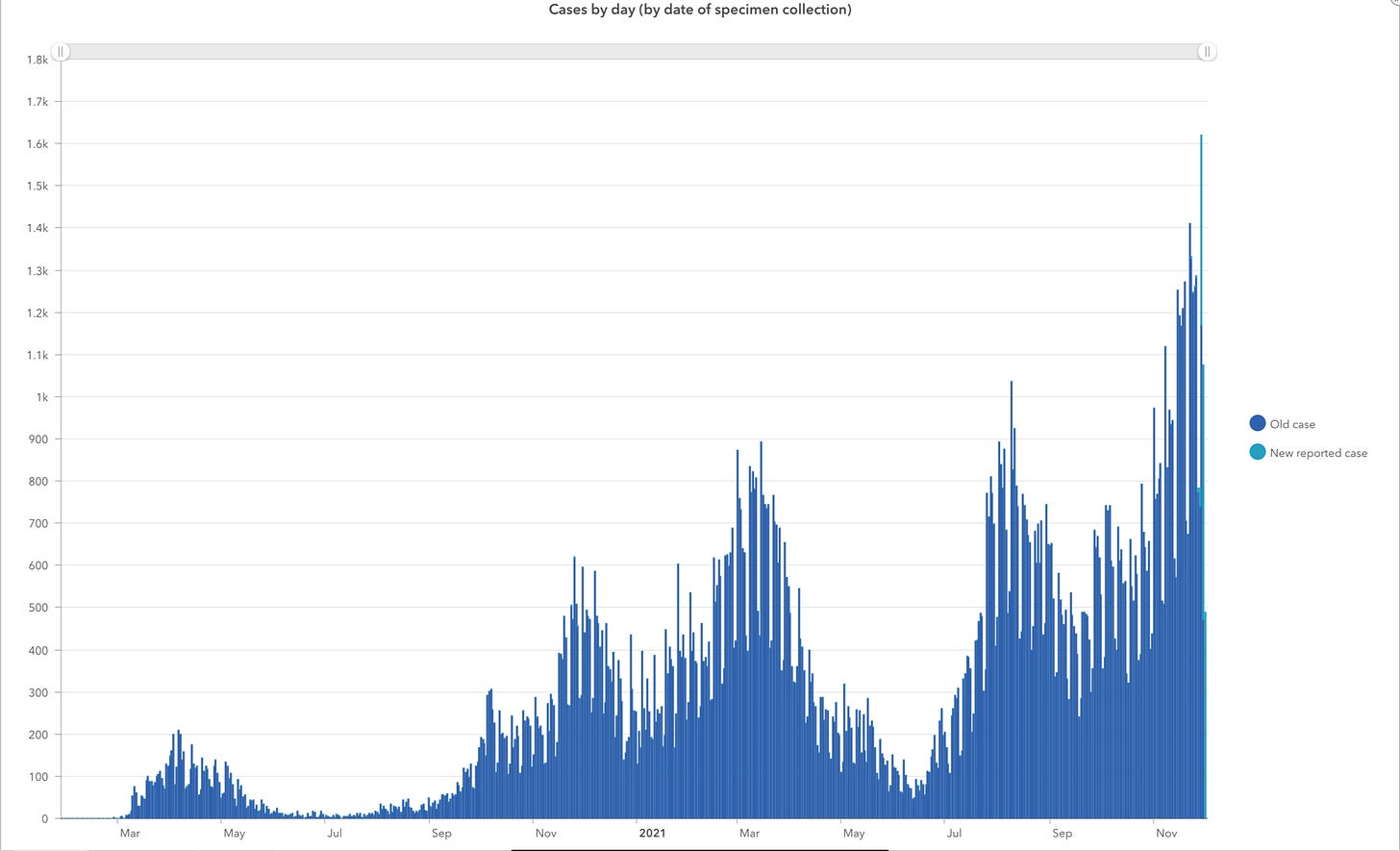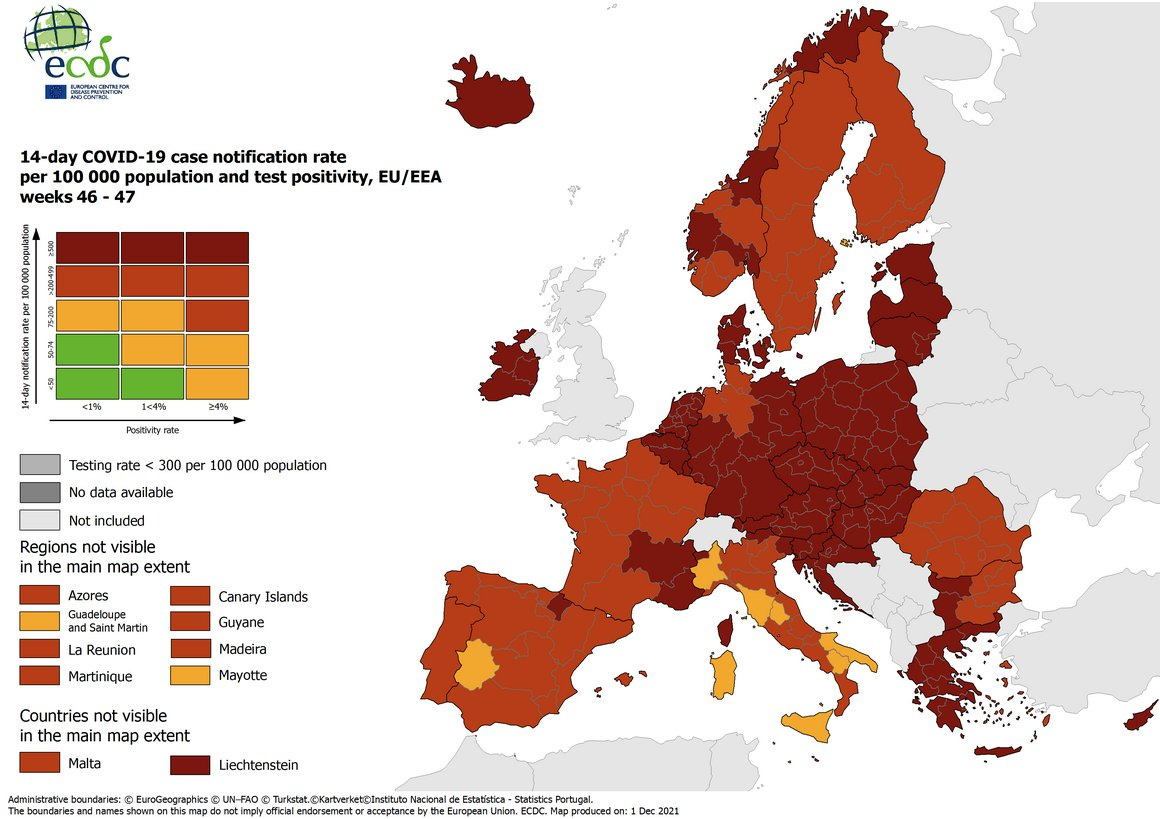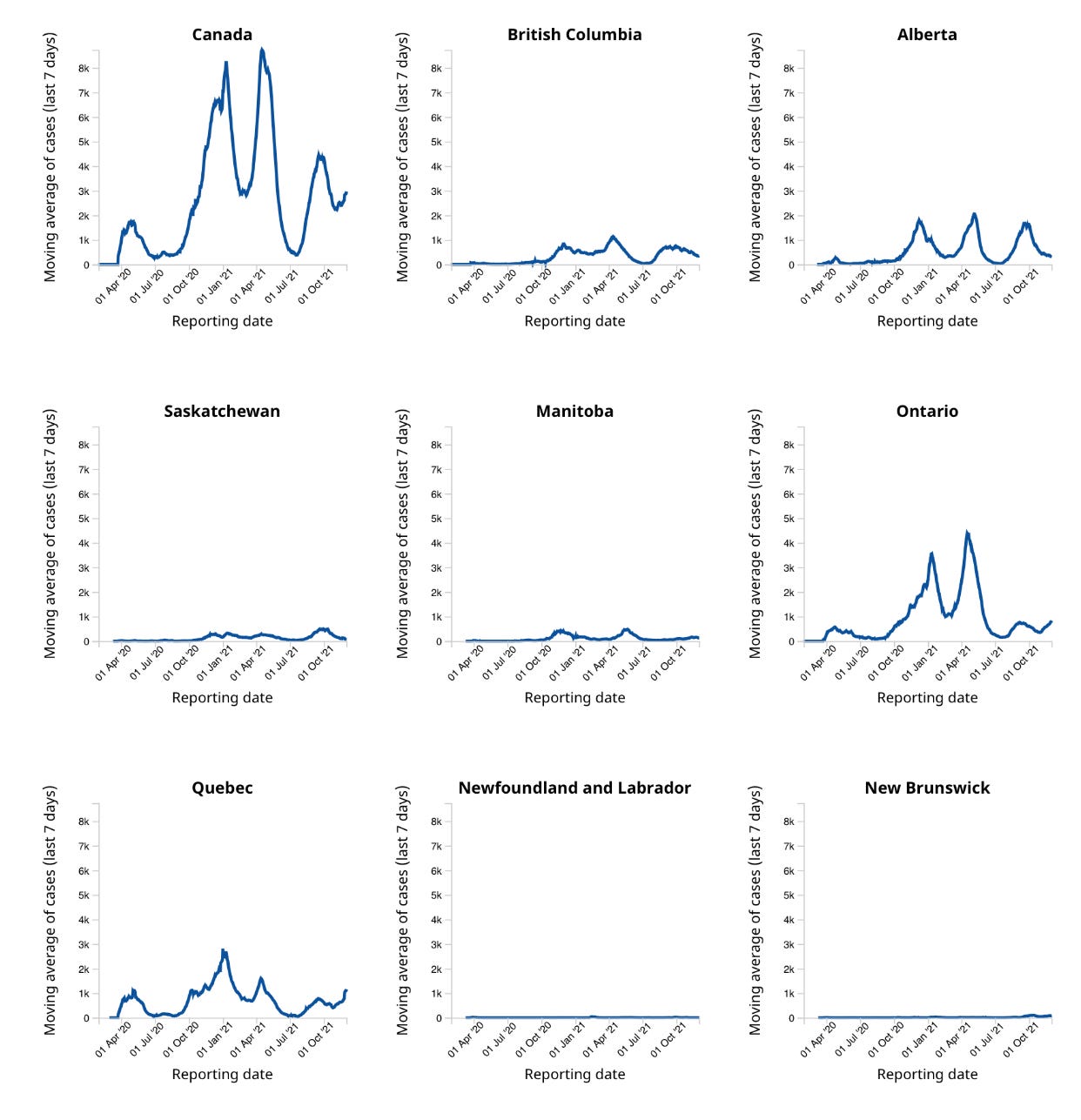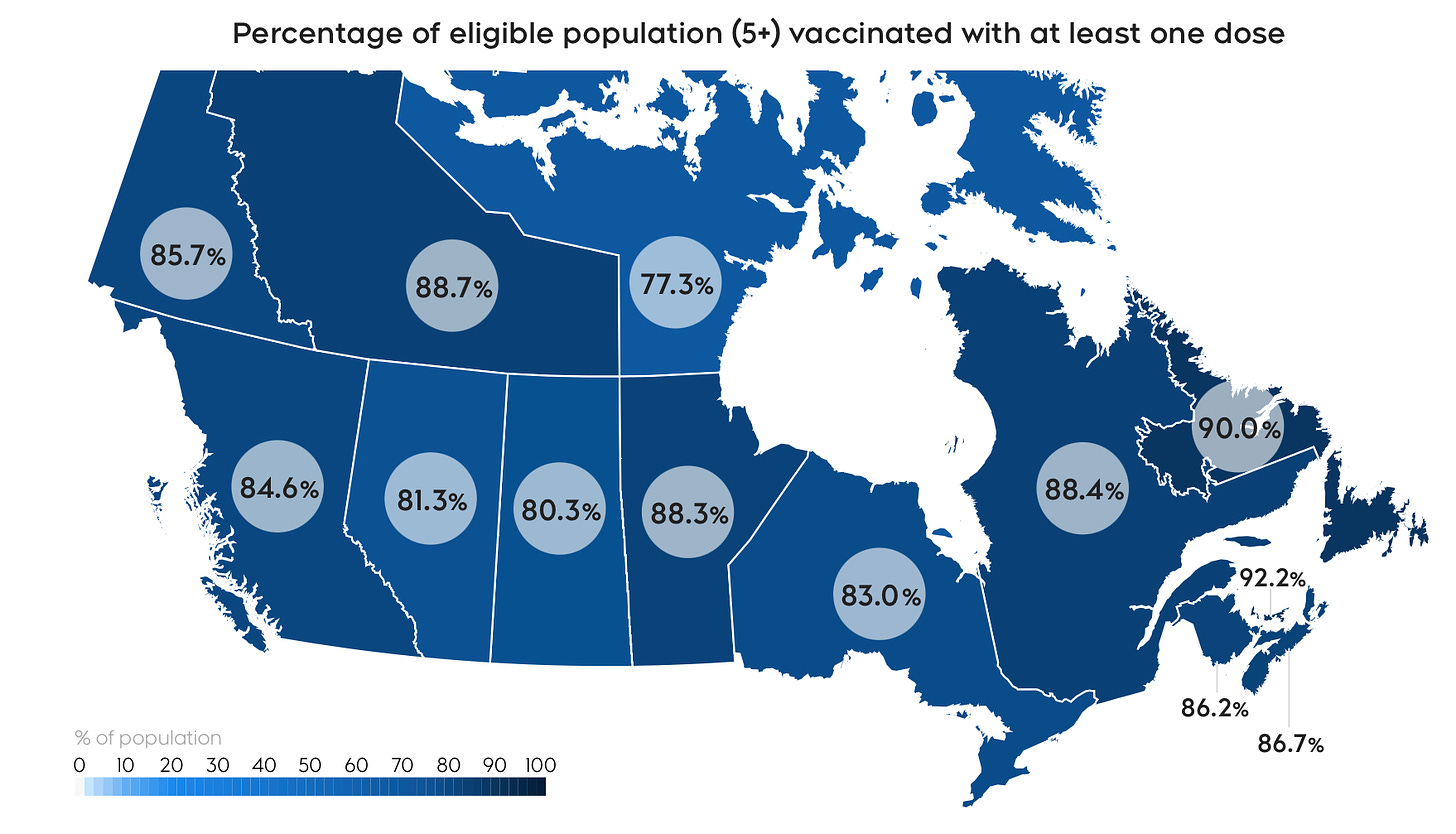🇩🇰
There are now 14 confirmed Omicron variant infection in Denmark, according to the Statens Serum Institut. It says 11 of those confirmed cases are travel-related. There are another 18 suspected cases, all awaiting genome sequencing test results.
-
Infection numbers and hospitalizations are easing a little, but COVID deaths have significantly increased in Denmark. The latest Staten Serum Institut epidemic assessment found new infections increased 3% last week compared to the week before, while hospitalizations were up 3.3%. In both cases, those are much smaller increases than have been seen in recent weeks. However, COVID deaths have jumped by just over 92% from one week to the next. Last week there were 73 corona deaths compared to 38 the week before.
Nationally, the COVID incidence rate per 100,000 people continues to climb, going from 480 in week 46 to 495 in week 47. Metro Copenhagen continues to be the epicenter of this latest infection wave, with a COVID incidence rate more than double anywhere else in Denmark.
Infection activity remains highest among school children aged six to 11 years old. The COVID incidence rate in that age group last week per 100,000 kids was a jaw-dropping 1,675. This also continues to increase week-to week.
Ward Doctor Rebecca Legarth:
“It is still the infection among the 6 to 11-year-olds that is helping to drive the epidemic right now.”
The report continues to find infection and hospitalization numbers are much higher among unvaccinated people. The risk of infection for someone who is unvaccinated is 2.6 times higher and the chances of being hospitalized are 4.6 times higher than it is for all fully vaccinated people 12 years old and older.
“According to our figures, there are currently 37 admissions per 100,000 people among the unvaccinated against 8 per 100,000 among those who are vaccinated, calculated for all groups from 12 years old and up.”
-
In the last two days the Danish Agency for Patient Safety has ordered more class to be closed due to COVID outbreaks. The closures impacted two schools both in Copenhagen. At Gerbrandskolen, all students in grades 4 and 5 have been ordered to go home. At Rådmandsgades Skole the closure impacts students in grades 2 through 5 as well as after school programs.
-
Denmark is reporting 4,680 COVID infections and three more coronavirus deaths in the last day.
Yesterday there were 369,849 total corona tests done, of which 189,695 were PCR tests equaling a positivity percentage of 2.47%.
-
Hjørring Kommune is the latest to breach a COVID incidence rate of 400 per 100,000 residents triggering local measures to try and wrestle the numbers down.
The municipality is encouraging everyone to get a rapid test with PCR tests reserved for close contacts or people who are symptomatic. The Kommune says it is working with Region Nordjylland to expand testing capacity.
People in the Kommune are advised to maintain social distancing, keep indoor areas ventilated, and use good hand hygiene.
While all schools and daycares remain open, they too must take measures, and the Kommune says parents will get more information on that soon. The measures would include a ban on school gatherings; classes are not allowed to mix, and parents would have to drop off and pick up their kids outside.
-
COVID hospitalizations (427) dropped (-12) while the number of infected people in an ICU (57) also declined slightly (-4) of those the number on a ventilator (35) is unchanged day to day.
-
On the vaccination front to date, 4,938 people had a 1st vaccination dose yesterday which is good news. 41,626 total inoculations were done yesterday with booster doses (33,276) accounting for most of them.
So far, 77.9% of the total population have one dose, 75.9% have two, and 15% have had a booster shot.
-
Denmark’s National Board of Health is striking a working group to assess and issue recommendations on which drugs can be used to prevent and treat COVID. The issue of what drugs are effective against COVID has been a matter of much contention in other jurisdictions and Danish health authorities want to fill a knowledge gap with medicines assessed and recommended by professionals.
Working Group Chair Simon Tarp:
“The working group will continuously select focus areas and prepare new recommendations, and the plan is to make 1-2 new recommendations every month. In this way, we can help ensure that the choice of drugs to prevent and treat COVID is always based on the latest knowledge and on recommendations of the highest quality.”
-
On the RS virus front, the picture continues to improve as the incidence rate per 100,000 people for the seasonal respiratory infection continues to decline. It dropped from 3 to 2 week to week. RS virus hospital admissions also continued to drop, with 56 last week compared to 80 the week before.
-
An anticipated soaring influenza infection wave has still not materialized with rates of the seasonal flu remaining very low.
🇸🇪
Sweden has added 2,437 infections and another three virus deaths since yesterday’s update.
To date, 7,599,423 1st vaccine doses (84.1% of the population 12 years old and older) and 7,162,242 2nd doses (79.3%) have been administered.
For those 65 years old and older 1,041,321 (47%) have had a booster dose.
-
The Swedish Public Health Agency has confirmed six Omicron variant infections so far.
Department Head Britta Björkholm said in a press conference Thursday that all six cases have travel links to South Africa.
“We have scaled up sequencing, we have been sequencing all positive samples of people who have been traveling abroad. If we have cases where we suspect Omicron, we sequence it immediately.”
Björkholm says none of the six have serious infections. She also advises people to not get panicked about the new variant.
“Of course we should be vigilant and have respect for the unknown. At the same time, it is the same virus that we have had to deal with for two years; the measures will be the same.”
-
The Swedish Public Health Agency is looking to mitigate an anticipated infection surge. The agency says Sweden has high vaccination coverage but not an even one noting that vaccination rates need to increase among people 50 years old and older.
CEO Karin Tegmark Wisell:
“An increase in vaccination coverage for an even and high level of protection across the entire population as well as a booster dose for the groups that have been invited to have one. This is necessary to slow down the increase in spread of infection that is now being seen in several regions.”
The healthcare agency has now tabled proposals to try and curb an increase in COVID cases. The measures include social distancing, recommendations people avoid public transit if they can and wear a mask on a bus, train, or ferry if they can’t.
For employers, the agency is encouraging them to allow employees to work from home wherever possible, conduct staff meetings remotely; avoid large gatherings. If employees have to be at work, then make sure they can do so while observing social distancing.
🇳🇴
Norway has added a whopping 5,691 infections and one more virus death since yesterday’s update.
COVID hospitalizations (262) are up (+5) while the number of infected people in an ICU (64) declined slightly (-4) of those the number on a ventilator (39) edged upward (+2).
To date, 78.7% of Norwegians 12 years old and older have had one vaccine dose, 71.2% have had two, and 12% have had a booster dose.
-
Like Denmark, Norway’s vaunted return to ‘normal’ has come to an end. As daily COVID infections push to record highs and concerns rise over the new Omicron variant Norway will reimpose coronavirus restrictions. In a press conference today, Norwegian Statsminister Jonas Gahr Støre reimposed a mask mandate for public transit, taxis, inside healthcare facilities, in shops, malls, and anywhere else where crowds cannot be avoided. The other measures include social distancing, avoiding shaking hands, and for people to reduce their social contacts. For employers, they should let people work from home where ever possible and hold work meetings remotely instead of in-person.
“The government is following the situation closely. We can not rule out that stricter measures will come later, if there is a need for it.”
The restrictions were announced after Norway confirmed its first Omicron variant infections and concerns ratcheted up after a Christmas party in Oslo resulted in over 50 COVID infections, with one of them - so far - testing positive for the new variant.
Health Minister Ingvild Kjerkol:
“Both the Norwegian Directorate of Health and Norwegian Institute of Public Health emphasize that it is necessary to implement measures quickly to delay the spread of the Omicron variant. It will give us time to gain more knowledge about the virus.”
On Monday, Norway extended mandatory quarantines to seven days for anyone testing positive and where there is reason to believe they are infected with the Omicron variant. Close contacts must be quarantined for ten days with an out if they test negative on day seven. Testing obligations were also tightened for close contacts of any suspected variant infections.
It also levied travel and entry restrictions on eight South African countries.
-
For a sixth straight week, Norway continues to see what the Norwegian Institute for Public Health calls steady increases in infection numbers. In its latest weekly COVID assessment, it says infection numbers last week increased 25% from the week before and are up six-fold over the last six weeks. The majority of new cases, 63%, are among those under the age of 40. Children six to 12 years old are seeing the highest number of coronavirus cases of any age group.
Hospitalizations rose slightly week to week, going from 151 patients admitted in week 45 to 164 last week. By age group then, the number of infected people 18 to 4 years old increased last week, while the NIPH says admissions were stable among all other age groups.
COVID deaths in Norway had been increasing for five consecutive weeks but dropped slightly last week with 42 fatalities compared to 46 the previous week. The median age for coronavirus deaths last week was 81.
Norway’s national health institute says the rate of COVID hospitalizations and deaths continues to be “significantly higher” among the unvaccinated population.
As of last week, the Delta variant continued its dominance in Norway, accounting for 99% of all sequenced positive test results. That said, the NIPH has confirmed two cases of the new Omicron variant this week, with two more suspected cases awaiting genome sequencing results. It is worth noting that the institute has emphasized that the Delta sub-variant is AY.4.2 is the most common strain in parts of the country.
-
On the RS virus front, the Norwegian Public Health Institute says infection numbers, while still very high, are now “sharply dropping.” The usual winter respiratory bug, which has come roaring back in the Nordics much earlier than has ever been seen before, accounted for 33% of hospital admissions last week to coronavirus’s 14%.
🇫🇮
For the fourth time in the last two weeks, Finland has registered another record-high number of daily COVID infections with 1,622. It also had eight more corona deaths in the last 24 hours.
So far, 76.4% of the total population has had one vaccine dose, 72.1% have had two, and 5.3% have had a booster shot.
-
The Omicron variant has arrived in Finland. The Finnish Institute for Health says a single infection case has been confirmed but it adds, other people in the same group have also tested positive for COVID and sequencing results are not yet back for them. The agency notes the group had just returned from a trip to Sweden.
-
A working paper from the Finnish Institute for Health has found that children very rarely experience serious cases of COVID and fewer yet are hospitalized. The agency studied all infection data from when the pandemic began up until November of this year. To date, 15% of all confirmed coronavirus infections since the pandemic began have been among children under the age of 12. Of those, 4% were chid,rem four years old and younger, and 11% were among kids five to 11 years old. The agency says while the proportion of infection in children has varied from one COVID wave to the next the highest proportion yet has been seen in recent weeks.
Chief Physician Emmi Sarvikivi:
“Of the coronavirus infections confirmed last week (week 46), 27% were diagnosed in children under 12 years of age.”
Contact tracing data shows the most common way children become infected is by their family and others close to them.
“This means that the vaccination of adults also protects children.”
The working paper found the vast majority of children who have been infected in Finland have mild or asymptomatic cases.
“Coronavirus patients under 12 years of age have not increased the burden of hospital care or health services in Finland despite them being unvaccinated.”
Finnish health registry as of November 21, a total of 113 children under the age of 12 have been hospitalized. Of those, 56% were infants under the age of one. In the entire pandemic, less than five children have been admitted to intensive care due to a coronavirus infection.
🇩🇪
Battling the most severe infection wave of the pandemic and record-high daily coronavirus numbers, Germany has come down hard on the unvaccinated. Federal and state leaders have agreed to bar unvaccinated people from all businesses except grocery stores and pharmacies. The German parliament will also vote on making vaccinations mandatory early next year.
The new measures will likely come into force in a couple of days.
Here is what was agreed on:
Shops, businesses, museums, theatres, cinemas etc, can only be accessed by those who are fully vaccinated or have immunity from a recent infection.
People who are unvaccinated will be tested much more frequently.
Unvaccinated people will be limited to having one other household over for private gatherings.
Bars, nightclubs, and other nightlife venues must close in areas where the COVID incidence rate hits 350.
The number of spectators will be capped at 15,000 at outdoor sports and at 5,000 for indoor stadiums.
Students will have to mask up in German schools.
Germany has one of the lowest vaccination rates in Western Europe with just under 69% of its population fully vaccinated.
🇪🇺🦠
The European Centre for Disease Prevention and Control has updated its threat assessment of the Omicron variant.
As of December 1, there have been 352 confirmed Omicron infections in 27 countries around the world. Among the European Union and greater European Economic Area there have 70 confirmed cases in 13 European countries. The ECDC says a majority of the cases have a travel history to countries in Southern Africa.
“All cases for which there is available information on severity were either asymptomatic or mild. To date, there have been no severe cases and no deaths reported among these cases.”
The agency says while there is a lot we don’t know about the variant yet, like its transmissibility, severity, and immune escape, preliminary information out of Africa continues to indicate it “has a substantial growth advantage over the Delta variant.” Mathematical modeling by the ECDC estimates that the Omicron variant will account for over half of all coronavirus infections in Europe “within the next few months.”
“Based on these factors, the probability of further introduction and community spread of the Omicron VOC in EU/EEA countries is currently assessed as HIGH. Based on the currently available limited evidence, and considering the high level of uncertainty, the overall level of risk for EU/EEA countries associated with the further emergence and spread of the SARS-CoV-2 Omicron VOC is assessed as HIGH TO VERY HIGH.”
The ECDC is urging EU countries to give “utmost priority” towards vaccinating their citizens and getting booster doses for everyone 40 years old and older first, then consider a 3rd dose for everyone 18 years old and up. It also recommends COVID restrictions like mask mandates, social distancing, making sure indoor spaces are well ventilated, and good hygiene practices. Contact tracing efforts should be stepped up and genome sequencing of positive test results should be of “utmost importance.”
On enacting travel bans, as many EU countries have, the ECDC is asking for a cautious approach with any bans regularly reviewed “as new evidence emerges.”
It backs the testing and quarantining of travelers from impacted countries.
“However, given the increasing number of cases and clusters in the EU/EEA without a travel history or contact with travel-related cases, it is likely that within the coming weeks the effectiveness of travel-related measures will significantly decrease, and countries should prepare for a rapid and measured de-escalation of such measures.”
🇪🇺💉
The European Medicines Agency has begun a rolling review of a COVID vaccine from a company called Valneva with the catchy name of VLA2001. The EMA will now analyze all data and clinical trials to determine if the vaccine is safe and effective. This vaccine uses an inactivated SARS-CoV-2 virus that cannot cause any disease along with two adjuvants, which help strengthen the immune system response to identity COVID and activate antibodies against it.
This is the 4th coronavirus vaccine currently under a rolling review by the European pharmaceutical watchdog.
🇪🇺🦠
Here is the latest COVID risk assessment map of the EU from the European Centre for Disease Prevention and Control. It is awash in shades of red, which is not good.
🦠🌍
Preliminary reports from the South African National Institute of Infectious Diseases spell potential trouble on the Omicron variant front. The Guardian and Der Spiegel report that the NICD and the World Health Organization believe the new variant may not be stopped via immunity from a previous COVID infection. NCID Professor of Microbiology Anne von Gottberg says initial data in the study seem to show a previous infection does not protect against the Omicron variant. She cautions these are preliminary findings and more work needs to be done to flesh it out.
🇨🇦
Canada reported 3,135 new corona infections while losing another 28 lives to the pandemic.
The Canadian vaccination effort has so far administered 30,677,009 1st vaccine doses (80.23% of the total population) while 29,013,191 people (75.88%) are fully vaccinated. To date, 949,694 vaccine booster doses have been administered.
In Ontario Thursday there were 959 infections, of which 469 were people who were unvaccinated or had a single dose. There are 261 people in hospital and of those 241 have one dose or none at all. Of the 155 people in an ICU, that number is 129. There babe been eight more deaths in the province.
Quebec reported 1,146 corona infections and two more virus deaths.
In Atlantic Canada, New Brunswick has 95 infections. Nova Scotia has 40. Newfoundland and Labrador had two.
Manitoba saw 172 new COVID cases and three more fatalities.
There were 71 infections and one more death in Saskatchewan Thursday.
Alberta logged 430 infections and seven more deaths. The province has a positivity percentage of 4.1%. There are 424 people in hospital, including 79 in an ICU, of which 85% are unvaccinated.
B.C. registered 375 coronavirus cases and seven more deaths. There are 301 people in hospital, including 98 in an ICU, of which 82% are not fully vaccinated.




